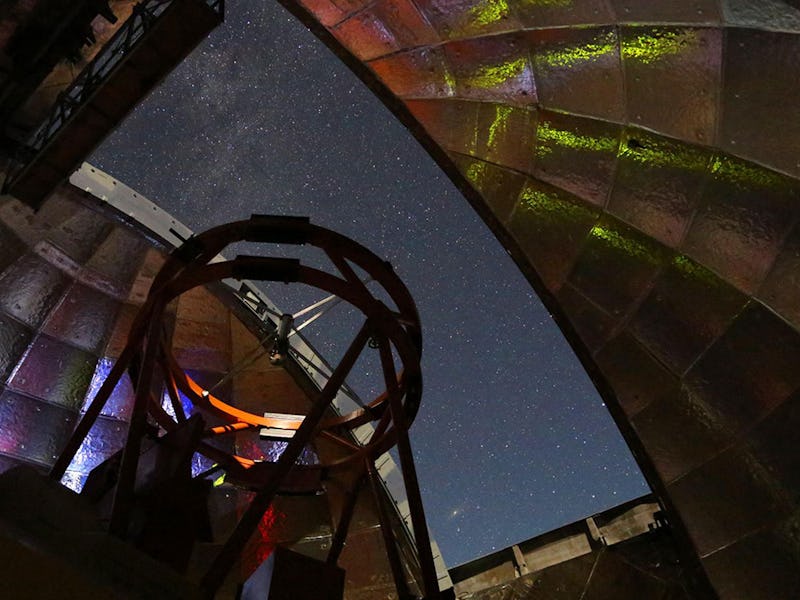You need to watch the biggest asteroid flyby of 2021 next week
The biggest asteroid to visit the Earth-Moon system in 2021 is coming early next week. Get your popcorn.

We’ve got a rather large cosmic visitor headed our way. But don’t worry too much.
On Monday, March 21, an asteroid about as long as the Golden Gate Bridge will zoom past Earth. While asteroid 2001 FO32 may be mighty in size but it will be too far away to do any damage. But it’ll still put on a show — at least via a telescopic live stream.
How to see asteroid 2001 FO32
The asteroid’s closest approach to Earth will be on Monday at 12:03 p.m. Eastern. However, it will still be visible for amateur astronomers peaking out at the night sky through their backyard, or through a telescopic online stream.
In a statement released to the press, Paul Chodas, director of the Center for Near Earth Object Studies (CNEOS), says that though the rock will be too faint to be spotted with the naked eye, amateur astronomers will be able to see the asteroid through their telescopes as it appears as a moving star in the sky.
The Virtual Telescope Project pinpointing the position of the asteroid set to visit us early next week.
“The asteroid will be brightest while it moves through southern skies,” Chodas says. “Amateur astronomers in the southern hemisphere and at low northern latitudes should be able to see this asteroid using moderate size telescopes with apertures of at least 8 inches in the nights leading up to closest approach, but they will probably need star charts to find it.”
If you don’t own a telescope, you can watch the asteroid’s Earth flyby through the Virtual Telescope Project’s website.
What’s new — The asteroid will come within 1.25 million miles away from Earth, a little more than five times the distance of the Earth to the Moon, according to NASA. It will be the largest asteroid flyby for the year 2021.
The asteroid is about 3,100 feet (about 0.6 miles) in diameter and between 1,300 to 2,230 feet wide, making it larger than around 97 percent of asteroids, but far smaller than the largest ones in our solar system.
A diagram showing the asteroid’s elongated and inclined orbit around the Sun, traveling at an unusual speed of 77,000 mph.
“We know the orbital path of 2001 FO32 around the Sun very accurately, since it was discovered 20 years ago and has been tracked ever since,” Chodas says. “There is no chance the asteroid will get any closer to Earth than 1.25 million miles.”
Why is asteroid 2001 FO32 potentially hazardous?
Here’s the background — Despite its currently-harmless nature, asteroid 2001 FO32 was classified as a potentially hazardous asteroid due to its massive size and its consistent visits near Earth.
NASA classifies any near-Earth object, whether it be an asteroid or a comet, as potentially hazardous if it makes close approaches to Earth and is large enough to cause significant damage.
Any asteroid over 459 feet wide that passes within five million miles of Earth is considered potentially hazardous, according to NASA.
The asteroid was first discovered on March 23, 2001 by the Lincoln Near-Earth Asteroid Research (LINEAR) near Socorro, New Mexico. It is one of the fastest asteroids to fly by our planet, speeding by at about 76,980 miles per hour or 21 miles per second.
The reason why it’s so fast is due to its eccentric orbit. The asteroid’s orbit around the Sun is highly inclined and elongated, tilted 39 degrees towards Earth’s orbital plane. As it travels around the Sun, the asteroid will get closer to the star than the planet Mercury and travel further away than the planet Mars, according to NASA.
As it travels within the inner Solar System, the asteroid picks up speed as it is drawn to the Sun’s gravitational tug, while slowing down as it moves further away from the Sun.
While we usually think of asteroids as confined to the asteroid belt in between Mars and Jupiter, in actuality, there are many in the inner solar system, as seen in this 2018 NASA-JPL simulation.
What’s next — FO32 completes one orbit every 810 days in an orbit that takes it through the paths of all four inner planets and far past the orbit of Mars.
The next time FO32 flies by our planet will be in 31 years on March 22, 2052, according to EarthSky.
However, Monday’s flyby will be its closest approach to Earth for the next 200 years.
The next asteroid to fly by Earth will be on March 25. The asteroid is called 2021EV3 and is classified as no risk at all at just 90 meters in diameter and at a distance of 4.5 million miles from Earth, according to the European Space Agency.